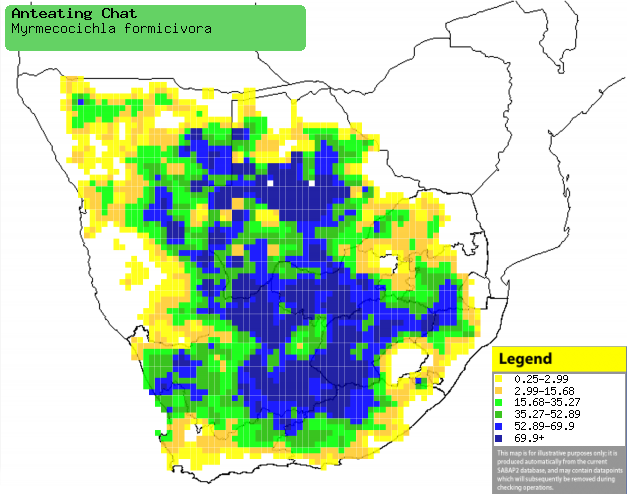|
Myrmecocichla formicivora (Ant-eating
chat)
Swartpiek [Afrikaans]; Isanzwili [Xhosa]; Thoromeli (also applied to
Capped wheatear), Thume (also applied to rock thrushes) [South Sotho];
Leping [Tswana]; Kaapse miertapuit [Dutch]; Traquet fourmilier [French];
Termitenschmätzer, Ameisenschmätzer [German];
Chasco-formigueiro-meridional [Portuguese]
Life
> Eukaryotes >
Opisthokonta
> Metazoa (animals) >
Bilateria >
Deuterostomia > Chordata >
Craniata > Vertebrata (vertebrates) > Gnathostomata (jawed
vertebrates) > Teleostomi (teleost fish) > Osteichthyes (bony fish) > Class:
Sarcopterygii (lobe-finned
fish) > Stegocephalia (terrestrial
vertebrates) > Tetrapoda
(four-legged vertebrates) > Reptiliomorpha > Amniota >
Reptilia (reptiles) >
Romeriida > Diapsida > Archosauromorpha > Archosauria >
Dinosauria
(dinosaurs) > Saurischia > Theropoda (bipedal predatory dinosaurs) >
Coelurosauria > Maniraptora > Aves
(birds) >
Order: Passeriformes > Family: Muscicapidae
> Genus: Myrmecocichla
Distribution and habitat
Endemic to southern Africa, occurring across Namibia,
Botswana and South Africa, while absent from Mozambique and most of Zimbabwe. It
generally prefers open grasslands, semi-arid shrubland, grassy hills and open,
arid savanna.
|
 |
|
Distribution of Ant-eating chat in southern Africa,
based on statistical smoothing of the records from first SA Bird Atlas
Project (©
Animal Demography unit, University of
Cape Town; smoothing by Birgit Erni and Francesca Little). Colours range
from dark blue (most common) through to yellow (least common).
See here for the latest distribution
from the SABAP2. |
Predators and parasites
- The eggs are eaten by Rhabdomys pumilio (Striped field mouse).
- Chicks can be infected with parasitic mites (Ornithonyssus bursa)
Brood parasites
It has been recorded as host of the
Greater honeyguide.
Food
It mainly eats insects, especially ants and termites, doing
most of its foraging on the ground in Winter, whereas in Summer it prefers to
pounce on prey from a low perch. The following food items have been recorded
in its diet:
Breeding
- Facultative cooperative breeder, meaning that the breeding pair are
sometimes helped by juveniles from the previous breeding season.
- The nest is a bowl of dry grass and roots placed in a chamber at the end
of a self-excavated burrow, which is usually about 30-150cm long. Both sexes
take about 8-10 days to do the excavation, usually digging into the roof of
an Aardvark (Orycteropus afer) burrow, sand wall, steam bank or sand
quarry.
- Egg-laying season is from August-March, peaking from October-November.
- It lays 2-7, usually 3 eggs, which are incubated solely by the female
for about 14-15 days.
- The chicks are fed by both adults and sometimes helpers, leaving the
nest after about 15-18 days. They remain dependent on their parents for
about 7-10 days more, after which they still use the burrow for shelter,
roosting and as a hiding place when they get alarmed.
Threats
Not threatened, in fact common across much of southern
Africa.
References
-
Hockey PAR, Dean WRJ and Ryan PG 2005. Roberts
- Birds of southern Africa, VIIth ed. The Trustees of the John Voelcker
Bird Book Fund, Cape Town.
|
